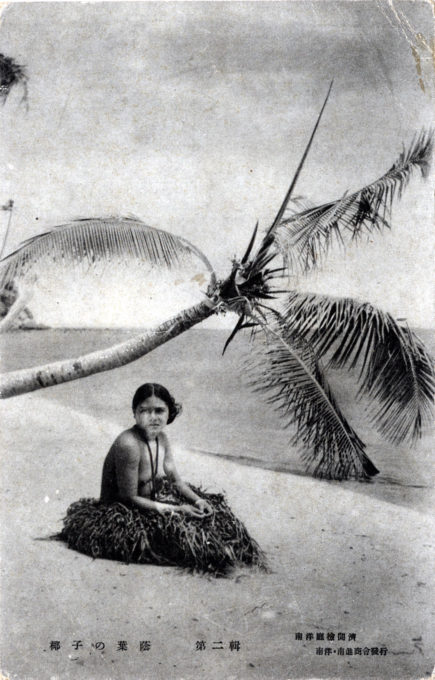“These groups of islands formerly belonged to Germany. They include the Marshall Islands, the Marianas, the Carolines and the Pelew Group. In the Treaty of Peace, signed at Versailles on June 28, 1919, the colonial possessions of Germany were surrendered to the Allied and Associated Powers, and these powers, through the conference, gave to Japan a mandate for the administration of all the islands, formerly in German possession, lying in the Pacific north of the equator.
“These islands are scattered over a vast stretch of ocean between the equator and 20° north latitude, and between the meridians 130° and 170° east longitude. They contain but 2,149 square kilometres, and the population is estimated at about 60,000, of whom 5,500 are Japanese. The importance of the islands, however, is not measured by the smallness of the population nor by the insignificant land area included. Their location in relation to American possessions is the matter of chief concern to the United States. They lie directly across the natural line of communication between Hawaii and the Philippines. Guam, belonging to the United States and having important cable communications, east and west, is located very nearly in the geographic center of the Japanese mandate possessions … It is to be remembered that [at the Peace Conference in Versailles] the American Government was still ignorant of the secret treaties of February and March, 1917, in which Great Britain and France pledged their support for Japan’s claim to the German islands north of the equator.
Map: South Pacific Mandates (highlighted in yellow), 1927. The South Seas Trading Company had an exclusive contract from 1915 with the Japanese Navy to provide freight, passenger, and mail services between the islands to the Home Islands. The routes were taken over by Nippon Yusen Kaisha (NYK) in the 1920s. The more luxurious amenities offered on board NYK’s vessels brought about the beginning of Japanese tourism to the islands.
“… The mandate given to Japan requires that annual reports shall be made to the League of Nations. These reports have been made very regularly and very fully by the Japanese Government. From these we learn that the military administration gave way in 1922 to a civil government. This government is under the control of the Director of the South Seas Bureau, which has its headquarters at Palau in the West Carolines. The bureau is organized upon scientific principles. Its methods tend to be paternalistic. If to some they appear to be annoying, they are at any rate efficient.
“Among the many improvements to be noted, is the attention given to the medical care of the inhabitants. A number of educational and judicial reforms have been introduced. Agriculture has been promoted and meteorological stations have been established … The chief industries of the islands are the growing of cocoanuts and sugar cane, the manufacture of sugar and copra, and the mining of phosphate at Angaur.”
– “Japan’s Mandate in the Pacific”, The American Journal of International Law, by E.T Williams, 1933
The South Pacific Mandate consisted of islands in the north Pacific Ocean, including present-day Palau, Northern Mariana Islands, the Federated States of Micronesia, and the Marshall Islands.
Before the establishment of the South Pacific Mandate, small groups of Japanese entrepreneurs established commercial ventures in German Micronesia and came to control a significant proportion of the trade. However, the economic development of the area was hampered by the distances separating the islands, their small land areas and their small market sizes. The mandate was initially a financial liability for the Japanese government, requiring an annual subsidy from Tokyo. During the 1920s and 1930s the Japanese government pursued a policy of encouraging monopolies that paired private initiative with government capital. This strategy was intended to maximise the number of Japanese colonists.
Until the late 1930s, the development of the islands was undertaken primarily to assist the Japanese civilian economy. But, by the early 1930s the sugar-related industries accounted for more than 60% of the mandate’s revenues. The Japanese also took over German phosphate mines on Angaur island and expanded them. Smaller phosphate mines on neighboring islands were also opened. Total exports to Japan eventually reached around 200,000 tons per year.
The South Seas Trading Company had an exclusive contract from 1915 with the Japanese Navy to provide freight, passenger, and mail services to the Empire as well as between the islands. The route between the Empire and the islands was subsequently taken over by the Japanese Mail Steamship Company (Nippon Yusen Kaisha), the largest steamship line in the Empire. The luxurious amenities offered on board some of the company’s vessels brought about the beginning of Japanese tourism to the islands.
The flying boat was the principal type of aircraft used for commercial aviation due to the shortage of flat land available for airfields. Imperial Japanese Airways began some commercial flights in 1935 using the long-range Kawanishi H6K2-L seaplane (known to the Allies of World War II as “Mavis”). Regular commercial flights were begun in 1940 and a regular service commenced in 1941. Commercial services ceased shortly after the start of Pacific War, but the widespread network of seaplane bases continued to be used during wartime.
– Wikipedia





